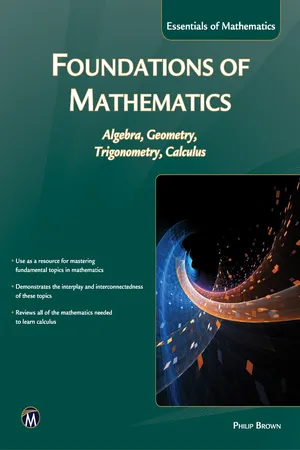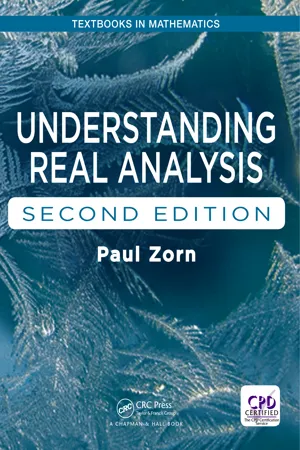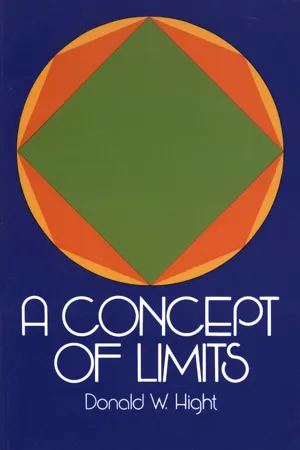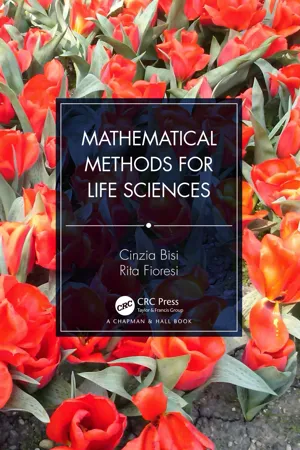Mathematics
Limits at Infinity and Asymptotes
Limits at infinity and asymptotes are concepts in calculus that deal with the behavior of functions as they approach infinity. A limit at infinity describes the behavior of a function as the input values approach positive or negative infinity. Asymptotes are lines that a function approaches but never touches, and they can be horizontal, vertical, or slant.
Written by Perlego with AI-assistance
Related key terms
Related key terms
1 of 4
Related key terms
1 of 3
8 Key excerpts on "Limits at Infinity and Asymptotes"
- eBook - ePub
Foundations of Mathematics
Algebra, Geometry, Trigonometry and Calculus
- Philip Brown(Author)
- 2016(Publication Date)
- Mercury Learning and Information(Publisher)
L.)DEFINITION 7.8.1. A line y = L is a horizontal asymptote of a function f(x) if and only ifWe demonstrate, by means of the examples below, how to compute a limit as x tends to infinity. The basic idea is that any fraction of the form where c is a constant and k is any natural number, tends to 0 as x tends to infinity (through positive or negative numbers).Recall that a rational function is a function of the form where p(x) and q(x) are polynomials. The function is a basic example of a rational function. We will see that a rational function has a horizontal asymptote whenever the degree of the numerator (the highest power of x in the numerator) is the same as, or less than, the degree of the denominator (the highest power of x in the denominator). In the following examples, we will let m be the degree of p(x) and n be the degree of q(x). The method of computing limits at infinity will require us to know the larger of the values of m and n. This is denoted “max{m, n}” (the maximum of m and n).EXAMPLE 7.8.1. Find the horizontal asymptotes of the rational functionAnswer: The degree of p(x) := x2 is m = 2 and q(x):= x2 + 1 is n = 2. Because max{m, n} = 2, we will factor x2 from the numerator and the denominator of f(x) so that all the terms that remain (after cancellation of the common factor) in the numerator and the denominator are constant terms or terms of the form where c is a constant and n is a natural number:Now, when we compute the limit, the term tends to 0. Thus,By the same reasoning, the limit as x tends to −∞ is also equal to 1:Thus, the horizontal asymptote is the line y = 1 (in both directions).EXAMPLE 7.8.2. Find the horizontal asymptotes of the rational functionAnswer: As in the previous example, we find that max{m, n} = 2, so we will factor x2 from the numerator and the denominator of f(x) in order to take the limit. Because the result will be the same whether x tends to ∞ through positive or negative numbers, we will take the limit as x - Mark Ryan(Author)
- 2023(Publication Date)
- For Dummies(Publisher)
If you’re asked to determine the regular, two-sided limit,, you have no choice but to say that it does not exist because the limits from the left and from the right are not equal. Limits and horizontal asymptotes Up till now, I’ve been looking at limits where x approaches a regular, finite number. But x can also approach infinity or negative infinity. Limits at infinity exist when a function has a horizontal asymptote. For example, the function in Figure 7-3 has a horizontal asymptote at, which the function gets closer and closer to as it goes toward infinity to the right and negative infinity to the left. (Going left, the function crosses and goes above the horizontal asymptote at (not shown in Figure 7-3) and then gradually comes down toward the asymptote. Going right, the function stays below the asymptote and gradually rises up toward it.) The limits equal the height of the horizontal asymptote and are written as and You see more limits at infinity in Chapter 8. Use Figure 7-4 for the example problems and for Problems 1 through 6. FIGURE 7-4: Not exactly your everyday graph. Q. A.. Because and because f is continuous there, the limit must equal the function value. Whenever a function passes through a point and there’s no discontinuity at that point, the limit equals the function value. Q. A.. There’s a hole at, and the limit at a hole is the height of the hole. 1 2 3 4 5 6 7 See the following graph of. Sketch by hand the function ; then refer to your sketch for Problems 8, 9, and 10. 8 9 10 Calculating instantaneous speed with limits If you’ve been dozing up to now, WAKE UP! The following problem, which eventually turns out to be a limit problem, brings you to the threshold of real calculus. Say you and your calculus-loving cat are hanging out one day and you decide to drop a ball out of your second-story window- eBook - ePub
- Paul Zorn(Author)
- 2017(Publication Date)
- Chapman and Hall/CRC(Publisher)
CHAPTER 3Limits and Continuity
3.1 Limits of FunctionsThis chapter is about continuous functions and their properties. As a foretaste, consider this reasonable‐sounding claim about a function f :If f ( - 1) = - 2 and f (1) = 5, then f (a ) = 0 for some a ∊ ( - 1, 1) .Is this true? If a graph passes through the pointsand( - 1 , - 2 ), must it also cross the x -axis somewhere in between? Must there also be an input b with f (b ) = π ?( 1 , 5 )Both answers turn out to be “yes”—if the function f is continuous everywhere along the input interval [−1, 1]. In this case, answers follow from the famous intermediate value theorem , which we will carefully state and prove later in this chapter. To prove such results we’ll draw on earlier work with completeness, suprema and infima, limits, the Bolzano–Weierstrass theorem, and more. Our work starts, as usual, with clear definitions of words like “limit” (as applied to functions) and “continuous.”The IV theorem says that the range of a continuous function has no “gaps”; details come later.Defining Limits of Functions
Most of us emerge from elementary calculus courses with a rough and ready view of function limits. To say that limx →3f (x ) = 5, for example, means something like f (x ) approaches 5 as x approaches 3, or f (x ) ≈ 5 when x ≈ 3.These views are not incorrect, but they are too vague to be useful for building theory or proving theorems. What exactly does “approaches” mean? How close to 3 must x be for x ≈ 3 to hold? We need a precise definition.Definition 3.1 (Limit of a function). Let f be a function whose domain includes an open interval I containing a , except perhaps for x = a . Let L be a number. We writeObserve, right away, two important subtleties about domains:if, for every ɛ > 0, there exists δ > 0 such that |f (x ) - L | < ɛ whenever x ∊ I and 0 < |x - a | < δ .limf( x )= L• At x = a : The value f (a ) itself need not be defined for the limit to exist at x = a . Indeed, the whole point of finding such a limit is often to do with a “missing” or mysterious function value. If f (a ) is defined, that’s fine, but it’s irrelevant to the definition, which avoids all mention of f (a - eBook - ePub
- Donald W. Hight(Author)
- 2012(Publication Date)
- Dover Publications(Publisher)
. A more general generalized limit definition can be formed to include even such “limits” as “infinity.” However, we shall not undertake such a task. If you have proceeded successfully this far in this book you should be quite capable of reading more advanced texts for a more general, more advanced point of view. (See modern texts in calculus, topology, and functions of a real or complex variable.) Also, if you have been a participating reader, you may be able to form extensions of the limit theory that we have discussed to include limit infinity, limits of geometrical configurations, limiting positions of secant lines of a circle drawn through a common point, and many other notions that might be original to you. The following exercises may disclose some possible extensions of the limit concept that we have studied.Exercises1. Prove that f = {(x, 2x)} increases without bound at-the-right.2. Prove that g = {(x, (1/x2 ))}, x ≠ 0 increases without bound at 0; that is, prove that for every real number M there exists a real number δ > 0 such that (l/x2 ) > M if 0 < |x – 0| < δ.3. Let A and B be ends of a diameter of any circle O. Consider a set of points pn on the circle that satisfy the following properties: p1 is B; p2 bisects the arc bisects the arc in general pn bisects the arc . What is the “limiting position” of the ordered set of points pl P2 , P3 , ···, Pn , ··· ?4. Consider the ordered set of points pl , p2 , …, pn , … in Exercise 3 and imagine secant lines drawn through A and pn for every n; that is, consider the ordered set of secants Ap1 , Ap2 , …, Apn, …. What is the “limiting position” of this ordered set of secant lines ?3–8 OverviewWe have studied in detail six types of limits; in abbreviated notation they are lim, - eBook - ePub
The Learning and Teaching of Calculus
Ideas, Insights and Activities
- John Monaghan, Robert Ely, Márcia M.F. Pinto, Mike Thomas(Authors)
- 2023(Publication Date)
- Routledge(Publisher)
We wrote earlier, “The rigorous/informal question is a real tension for teachers and one that underpins much of what we discuss in this chapter”. This section explores this tension by contrasting mathematical accounts of limits and continuity with possible student interpretations. Our main focus is the meanings given to the term ‘limit’, but we also consider continuity and the terms ‘approaches’ and ‘converges’; this focus mirrors the foci of mathematics education research in this area.A first discussion of limits in a calculus classroom may concern limits of sequences or limits of functions. We consider sequences first. Spivak (2008) is a well-respected calculus book. Its chapter on infinite sequences starts (p. 372):The idea of an infinite sequence is so natural a concept that it is tempting to dispense with a definition altogether. One frequently writes simply “an infinite sequence a1 , a2 , a3 , a4 , a5 , …” the three dots indicating that the numbers ai continue to the right “forever”.Spivak then provides a definition, “An infinite sequence of real numbers is a function whose domain is ℕ”. We do not disagree with this description or definition, but we have some questions from the student point of view:EdumatterConsider the following:- Why are sequences introduced in a calculus course? What is their role in developing the ideas of differentiation and integration?
- How natural do students find an infinite sequence? What examples of infinite sequences in nature might they have experience of?
- What does ‘forever’ mean? To the mathematician this word is atemporal, the sequence does not develop over time, but the student may bring time into their ideas on the matter, “How can something go on forever? You’d run out of time”.
- The definition describes an infinite sequence as a function. To the mathematician this is clear because a function, f, is a set of ordered pairs of numbers such that if (a, b) ∈ f and (a, c) ∈ f, then b = c and the first member of each ordered pair in the infinite sequence is a natural number (the suffixes in a1 , a2 , a3 , a4 , a5
- Mark Ryan(Author)
- 2018(Publication Date)
- For Dummies(Publisher)
Of course, it’s obvious that. Finding a function for the top slice is harder. But say that for some mysterious reason, you know that is greater than near the arrow-number (the only place that matters for the sandwich method). Because, makes a good top slice. You’re done. Because is squeezed between and, both of which have limits of 0 as x approaches 0, must also have a limit of 0. 19 Evaluate. 20 Evaluate. Into the Great Beyond: Limits at Infinity To find a limit at infinity or, you can use the same techniques from the bulleted list in the “Solving Limits with Algebra” section of this chapter in order to change the limit expression so that you can plug in and solve. If you’re taking the limit at infinity of a rational function (which is one polynomial divided by another, such as), the limit will be the same as the y value of the function’s horizontal asymptote, which is an imaginary line that a curve gets closer and closer to as it goes right or left toward infinity or negative infinity. Here are the two cases where this works: Case 1: If the degree of the polynomial in the numerator is less than the degree of the polynomial in the denominator, there’s a horizontal asymptote at y = 0, and the limit as x approaches or is 0 as well. Case 2: If the degrees of the two polynomials are equal, there’s a horizontal asymptote at the number you get when you divide the coefficient of the highest power term in the numerator by the coefficient of the highest power term in the denominator. This number is the answer to the limit as x approaches infinity or negative infinity. By the way, if the degree of the numerator is greater than the degree of the denominator, there’s no horizontal asymptote and no limit. Consider the following four types of expressions:,,, and. If a limit at infinity involves a fraction with one of them over another, you can apply a handy little tip- eBook - ePub
- Cinzia Bisi, Rita Fioresi(Authors)
- 2024(Publication Date)
- Chapman and Hall/CRC(Publisher)
2 Limits and DerivativesDOI: 10.1201/9781003343288-22.1 Limits
The concept of limit represents the foundation of differential and integral calculus: it tells us how the value f(x) of a function f changes as the variable x approaches a value x0 .For example, consider the linear function f(x) = x + 3. We see that f(x) approximates the number 5, as x approaches the value x0 = 2. We can easily see it, if we substitute the value 2 for x: f(2) = 2 + 3 = 5 and we look at the graph of the line y = x + 3. Indeed, for values of x close to the point x0 = 2 on the x-axis, the corresponding values of the function f are very close to f(2) = 5.x f(x) 2 5 2.1 5.1 1.9 4.9 As we shall see, we need the definition of limit to understand the values of the function f at x “near” x0 , when we cannot evaluate the function f at x0 .Definition 2.1.1 Let f : D → ℝ and suppose that f is defined at all points of an open interval containing x0 , but not necessarily in x0 . We say that the real number L is the limit of f(x) for x approaching x0 , if, for every ε > 0, there exists δ > 0 such that, if 0 < |x − x0 | < δ, we have:| f ( x ) − L | < ϵWe write in formulas:limf ( x ) = Lx →x 0Let us see an example.Example 2.1.2 We want to check that the limit of the function f(x) = x + 3, for x approaching 2, is equal to 5, as we intuitively anticipated at the beginning of this section:limx + 3 = 5x → 2We must show that, for any number ε > 0, we can always find a number δ > 0, such that if 0 < |x − 2| < δ, then |x + 3 − 5| < ε. Let us start by examining the last inequality:| x − 2 | < ϵ ⇔ 2 − ϵ < x < 2 + ϵSo if δ = ε, we have 0 < |x − 2| < δ.We invite the reader to check by exercise, using the reasoning of the previous example, that:(2.1)limx =x →x 0x 0,limk = kx →x 0where k ∈ ℝ is a constant.We can also define the right-hand limit and the left-hand limit of a function at x0 .- Right-hand limit: We define lim x
- eBook - ePub
- Auguste Comte(Author)
- 2012(Publication Date)
- Perlego(Publisher)
limits of a collection of uniform motions of constantly diminishing durations, and so on.Examples. 1. Tangents. Suppose, for example, that we wish to determine the direction of the tangent to a curve; we will regard it as the limit towards which would tend a secant, which should turn about the given point so that its second point of intersection should indefinitely approach the first. Representing the differences of the co-ordinates of the two points by Δy and Δx, we would have at each instant, for the trigonometrical tangent of the angle which the secant makes with the axis of abscissas,t = Δy/Δx;from which, taking the limits, we will obtain, relatively to the tangent itself, this general formula of transcendental analysis,t = L(Δy/Δx),the characteristic L being employed to designate the limit. The calculus of indirect functions will show how to deduce from this formula in each particular case, when the equation of the curve is given, the relation between t and x, by eliminating the auxiliary quantities which have been introduced. If we suppose, in order to complete the solution, that the equation of the proposed curve is y = ax2 , we shall evidently haveΔy = 2axΔx + a(Δx)2 ,from which we shall obtainΔy/Δx = 2ax + aΔx.Now it is clear that the limit towards which the second number tends, in proportion as Δx diminishes, is 2ax. We shall therefore find, by this method, t = 2ax
Index pages curate the most relevant extracts from our library of academic textbooks. They’ve been created using an in-house natural language model (NLM), each adding context and meaning to key research topics.
Explore more topic indexes
Explore more topic indexes
1 of 6
Explore more topic indexes
1 of 4







